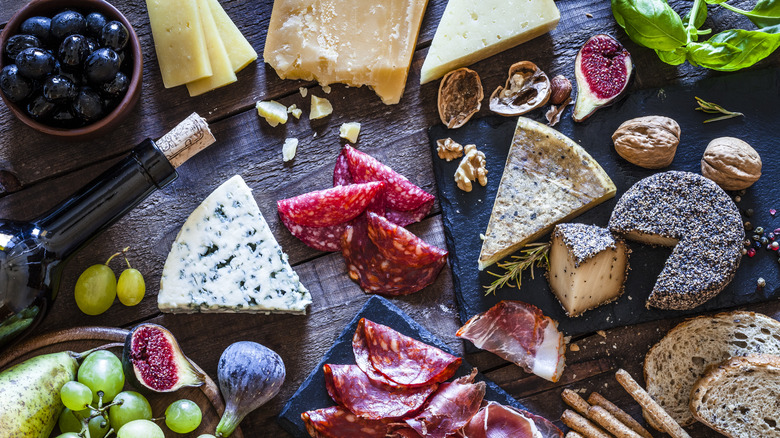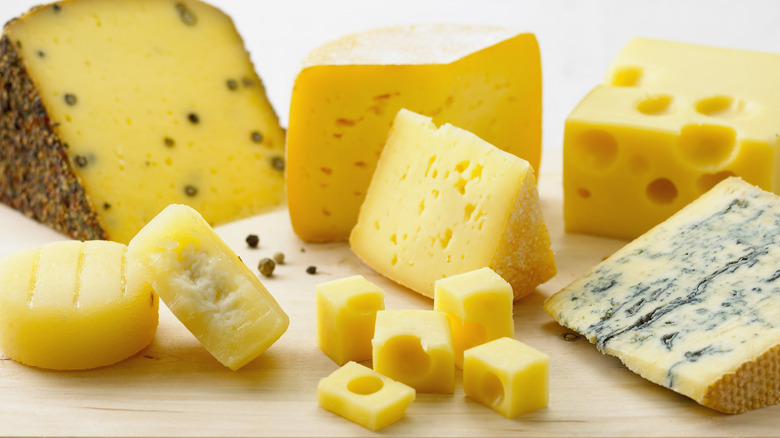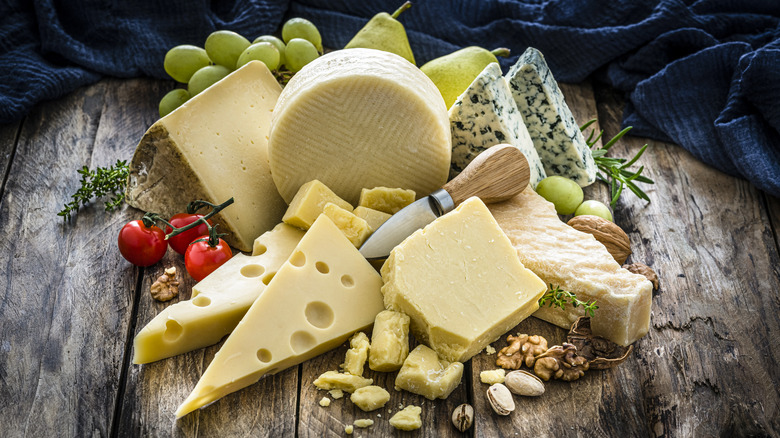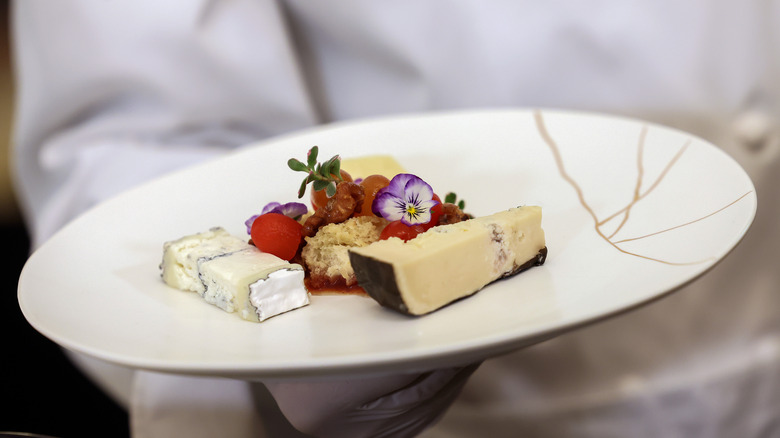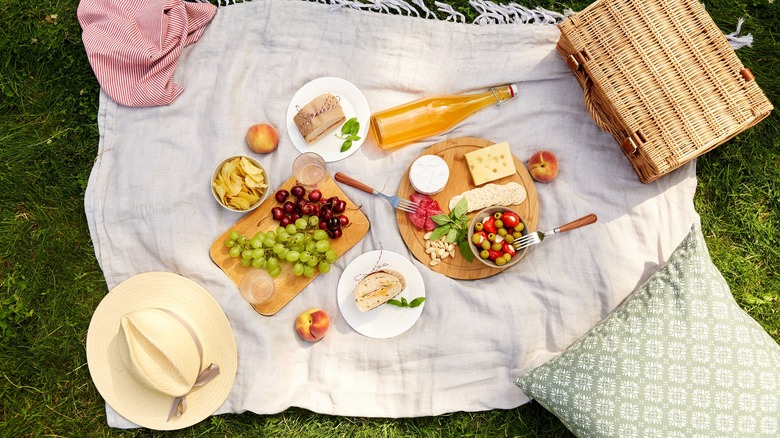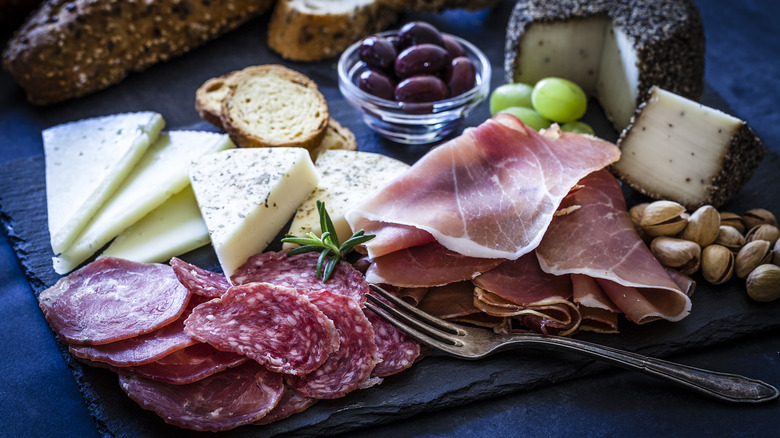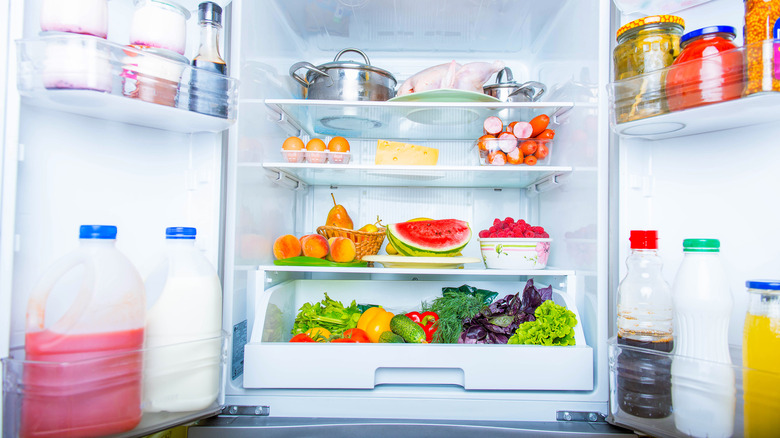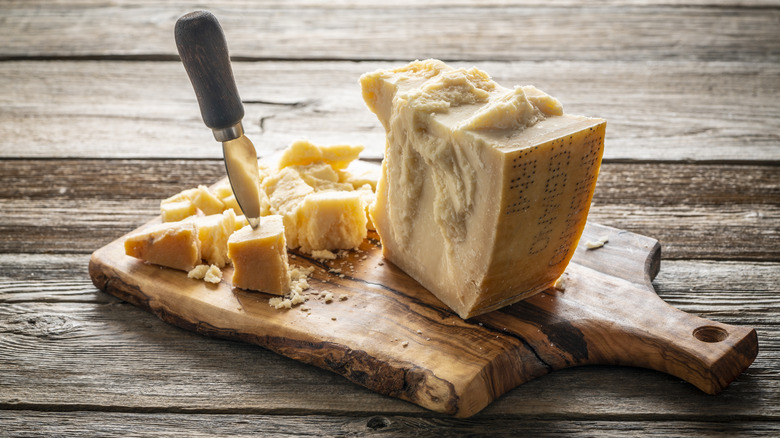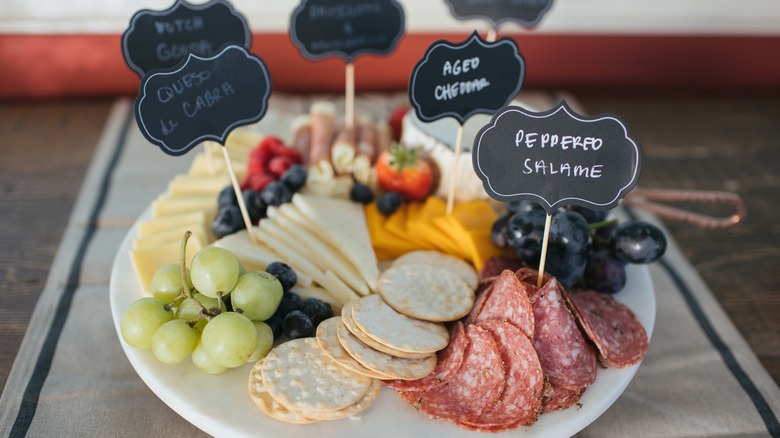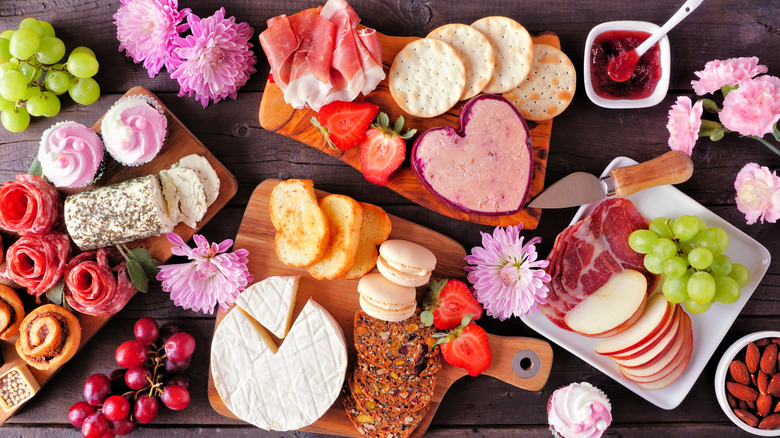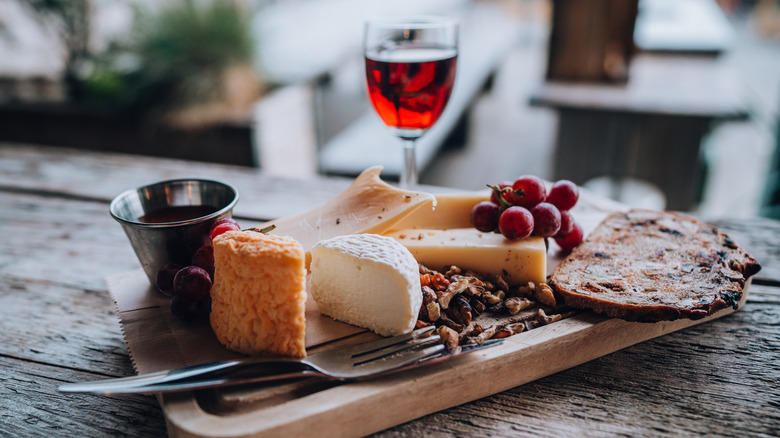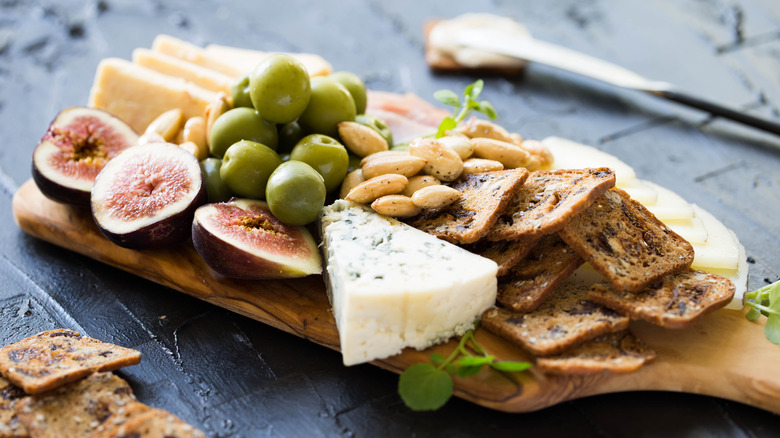12 Tips For Putting Together The Ultimate Cheese Board
A cheese board is a delicious addition to gatherings and can be served in a variety of ways. From a complete meal for two to an appetizer at a large dinner party, this versatile dish is sure to please. From mild favorites like cheddar to hard-aged Parmigiano Reggiano, pungent blue cheese, creamy Camembert, and the stinky cheeses people either love or hate, there are cheeses for every taste. Besides the mouthwatering ingredients, cheese boards are also known for their visual appeal as the different textures, colors, and sizes of the cheeses and accouterments come together to form a beautiful whole. A simple online search will reveal countless images of fantastic presentations, and trying to create the ultimate cheese board may seem intimidating to many people.
Making an excellent cheese board doesn't need to feel daunting. Jess Beer is the retail director for Weavers Way Coop, a cooperative grocery store with locations in Mt. Airy, Chestnut Hill, and Ambler, Pennsylvania, which sells specialty cheeses in its deli departments. She is a certified cheesemonger and all-around cheese lover, and she shares her extensive knowledge to provide tips on making an excellent cheese board. These suggestions will help make it easy to choose ingredients and arrange them in a way that's sure to delight and impress your guests.
Choose a variety of cheeses
A good cheese board should have a delicious variety of cheeses that go well together. With so many cheeses on the market, how do you choose the right selection? According to Beer, you could go for a wide variety with "having something that's soft and something that's hard, something that's in the middle, and a blue cheese." Or, she continues, you can choose an assortment with the same firmness. "One of my favorite ways to achieve a board is using all soft cheeses and picking maybe one goat, one cow, one sheep, or one goat and one sheep," she explains, adding, "You can have fun with accouterments and pairings that really go well with that style."
To find good quality and variety, Beer recommends looking for a small shop with cheese professionals when possible, like a smaller deli, a cooperative, or a mom-and-pop cheese shop. She suggests talking to the people behind the counter because they are inspired, passionate, and excited about cheese and can give you knowledgeable tips on pairings and accouterments. She does point out that great cheese can be found in a regular grocery store as well, which usually stocks some kind of Gruyère, Irish cheddar, Brie, Camembert, goat cheese, and perhaps an Italian Taleggio.
Select the right number of cheeses
You've decided on a theme for your cheese board, but how many cheeses should you include? You may want to load up your board with all the mouthwatering varieties you see, but for a balanced cheese board, less is more. First, think about how many people will be enjoying the dish, and whether they will eat a big meal afterward. If you're making a cheese board for two people to enjoy for dinner, Beer recommends choosing about two cheeses and really focusing the accoutrements and pairings on those picks.
You can scale that up for a party, notes Beer, although she cautions not going above five cheeses. In that case, "Your palate is going to get confused and not be able to pick up the nuances of the different flavors," she explains, adding, "less is more in terms of variety, so you can have more than one or two bites of a cheese you're really enjoying." About 1 ounce of cheese per person is a good general target if the cheese board will serve as an appetizer, while if the dish will be the main course, 2 ounces per person will be better. Beer points out that it's important to know your audience because cheese lovers will appreciate up to 4 ounces of cheese per person.
Consider your audience
Keep in mind the tastes of your guests when selecting cheese. While pungent cheese is a must-have for certain cheese aficionados, others will appreciate milder flavors to munch. Beer recognizes, "A bold blue or really stinky cheese isn't going to translate to folks who have a palate that isn't as accustomed to such bold and unique flavors." She recommends sticking to smaller portions of the strong stuff and going heavier on cheeses that are more subtle and mild, but still delicious, especially if you don't know that much about the preferences of the crowd.
This is a good opportunity to introduce cheeses that people may not have had before but that are still approachable to the general diner. Her suggestions for approachable cheeses include raclette, Gruyère, fresh mozzarella, chèvre, and Basque sheep's cheeses such as Petit Basque and Ossau Iraty. The two sheep's cheeses in particular, Beer explains, are "pretty widely available, buttery and rich and unique, but easy going and everybody likes them."
Include some non-dairy options if you have guests with special dietary requirements. You could include non-dairy cheese or just go heavier on accoutrements. Beer notes that many snack foods go well with cheese and recommends olives, pickles, cut-up fruit and veggies, and dips like hummus and white bean spreads that don't contain dairy.
Add accompaniments
Despite its name, the ultimate cheese board is going to contain more than just cheese. The accompaniments can be said to be just as important as the cheese itself, giving the dish color, contributing to a beautiful, mouthwatering presentation, and proving complementary and contrasting flavors that boost the enjoyment of the actual cheese. Balanced additions in the right quantities can also turn the board into a complete meal by itself.
"Cheese is really salty, so having fresh things available is the best accompaniment," Beer notes. She recommends whatever fresh fruit is in season and some cut-up raw vegetables like carrots, cucumbers, and radishes, because "anything that's fresh is going to cut through the salt." She advises adding something with a bit of sweetness, like local fruit jam or preserves. The sweetness balances salty cheese as well, and sweet and salty flavors are extra delicious when paired because we have extra sweetness receptors on our tongues that turn on when sugar and salt are detected together.
"Toasted nuts are always a nice accompaniment with cheese," Beer continues, adding, "Harder cheeses have a nuttier flavor to them, so that can be [a] really fun pairing." Any nuts are fair game, including cashews, pistachios, pecans, and hazelnuts. Bread (Beer notes that sourdough goes well with soft cheeses) or crackers give you something to spread the cheese on and are also delicious by themselves. Cured meats if desired, and something briny such as cornichons or olives round out the plate.
Incorporate meat
While a charcuterie board, which focuses on meat, and a cheese board are different things, a cheese board can include meat that complements the cheeses on offer, as long as the cheese remains the focal point. Italian cured meats are a popular choice, and people often reach for them when choosing the best meats to include on a cheese or charcuterie board. Beer says she often includes cured meats on her cheese boards because they add different flavors and components that can be really delicious with cheese, but she doesn't always include them. She usually reaches for prosciutto, cured salami, soppressata, or perhaps something a little spicy.
She mentions that "more unique flavors" like a fennel salami or a rosemary ham "are really fantastic to round out the board as well." As far as quantity, Beer states that it depends on the crowd, but, generally, less is more with meat. She recommends 1 to 2 ounces added to the board per person.
Serve cheese at room temperature
With all the care and attention you are giving to creating an excellent cheese board, don't make the mistake of placing refrigerator-cold cheeses on the plate right before your guests arrive. Cheese contains animal fat, which is solid at room temperature, and even firmer in the fridge. The fat molecules, which are responsible for the flavor, condense in the cold, depriving the cheese of the full taste and creaminess it develops after warming back up.
Beer likens it to "a really cold day outside when your shoulders are scrunched up and in close to you. Then when you get into your house, after a little bit you're warm and feeling looser. Cheese is like that too. When it's looser and warmer, the flavors are going to be more pronounced, and you're going to get its full essence."
How far ahead of time should you take the cheese out of the fridge? Beer notes that it depends on how warm it is. If your kitchen is warm, either from the time of year or because you're cooking a lot, then one hour ahead is fine. On a cold wintry day, on the other hand, she recommends taking it out two hours before serving.
Provide the right tools
The cheese board itself will provide a structure to arrange your cheese and accompaniments. While some are more elegant than others, any kind of plate, tray, or cutting board will get the job done. You can also consider the aesthetics and materials of the board for additional beauty or practicality. As a cheese enthusiast, Beer uses a few different boards, including a slate board and one made of olive wood. She remarks that it comes down to personal preference and style. "Slate is very easy to keep clean and you can throw it in the dishwasher," she says, while "bar boards are really delicate. You have to be careful about drying them off." She pulls out her larger ceramic pieces for a party.
Having the right cutting tools will help with preparation. Beer recommends cutting or slicing most cheeses before arranging them on the board. She uses a small paring knife to break off bite-sized chunks of hard cheeses like very aged Gouda or Parmigiano Reggiano, and a regular chef's knife to slice firm cheeses. "The soft cheeses and blues are the only ones I would put out an individual knife for," Beer points out. While there are many sophisticated tools and beautiful sets out there, she adds that "any sort of small spreader knife or soft cheese knife" will be fine for this purpose. However, she does recommend using one knife specifically for each soft cheese so it doesn't get cross-contaminated with the other flavors.
Focus on the arrangement
A beautiful arrangement is half the fun of a cheese board, and a visually appealing display will make the whole platter even more appetizing. The first step, according to Beer, is to cut all but the soft cheeses before placing them on the board. She slices harder smooth-bodied cheeses into ¼ inch slices "so people get to experience the texture of the cheese without the commitment of a huge slice." She points out that rough nuggets of hard cheeses like Parmigiano "look really beautiful on the plate." For the soft cheeses, she explains, "I like to cut out the first piece so you can signal to your guests how to best cut the piece of cheese because it can be a little intimidating. If it's a little wheel, that means cutting a small wedge out of it. I'm just leading the way."
Beer likes to keep each cheese separate and distribute them throughout the board and then place the accoutrements like cut-up fruit and veggies, nuts, and little bowls of jam and olives in the gaps. Sometimes she will arrange edible flowers on top to make it look "really spectacular." Another tip that may help your guests navigate your board is to label your cheese with little signs. This will help guests unfamiliar with certain cheeses to understand what they are tasting and learn new things. It will also save you from reciting names and descriptions throughout the length of the party.
Consider the season
Traditionally, fresh cheeses were only eaten when goats, sheep, and cows produced milk during certain parts of their lactation cycle, Beer explains, and some of that milk was turned into aged cheeses to eat in the winter. In today's global marketplace, many fresh cheeses are available year-round, but the natural cycle still influences our tastes. "When it's hot out, you don't want to eat intense bold flavors like a super-aged Gouda or a really intense Gruyère," remarks Beer. "Similarly to how we want salads and fresh produce, we want fresh and soft cheeses when it's warm out, like fresh mozzarella, chèvre, or aged fresh cheeses with a nice acidity and brightness. And then when it's cold out, we want those umami-rich flavors, things that are denser, things that are more aged."
Considering the season when selecting cheese for your board will also help the cheese pair better with the accoutrements. Beer suggests choosing fresh produce that is in season and serving the preserves that are available that time of year. In the spring, that could mean a rhubarb or sour cherry jam. In the fall, she suggests a caramelized onion jam or an apple chutney for an Alpine cheese board, because the "deeper, more autumn flavors play off the nutty, sweet, umami-rich notes of that cheese." A holiday theme can be a fun inspiration, like this Thanksgiving cheese board with cranberry chutney and apple butter or a Valentine's Day cheese board with romantic colors.
Add contrast to your board
Creating contrast when designing a cheese board is a way to complement the flavors of the cheeses and boost the enjoyment of the dish as a whole. Add contrast with sweet and acidic ingredients, or elevate your cheese board with Giada De Laurentiis's fig jam mixed with Calabrian chili paste for a completely unexpected flavor combination. Beer notes that something sweet like jam goes very well with the saltiness of the cheese, and points out that honey and goat cheese is an especially good pairing. If you're serving meat on your cheese board, she recommends including pickles, because the acidity cutting through the fattiness of meats like salami or prosciutto tastes fantastic.
Not all pairings need to be food ingredients. Beer points out that Champagne provides excellent contrast for a cheese board. The acidity and bubbles go especially well with a rich product like a luxurious triple crème cheese that is fatty, salty, and buttery. In addition, it's refreshing and works as a palate cleanser to help you continue to enjoy more flavors.
Pair with wine
Pairing cheese with wine is a great way to add more complementary flavors to the cheese plate experience. Wine pairings can be a bit intimidating for many folks, but there are a few general concepts that can be applied to pairings for cheese. Beer recommends drinking something with a little bubble to it when enjoying a cheese plate. Lambrusco, a slightly sparkling Italian red wine, is an excellent choice, and so is Prosecco, which is more widely available. According to Beer, these sparkling wines pair really well with the salty, rich flavors of many different kinds of cheese, while simultaneously acting as a natural palate cleanser.
For those who must drink red wine, she recommends a Gamay or Pinot Noir because they are lighter wines, which pair better with cheese. Another option is a light-bodied, or neutral oaky, Chardonnay, which pairs especially well with soft cheeses and Alpine cheeses. She cautions against strong reds like Cabernet Sauvignon or Barolo. While excellent wines, pairing one with cheese, especially strong types like blue cheese, is "not going to do a service to such a great bottle of wine," explaining that "those flavors and tannins are so intense they actually clash with most cheese, and it's not going to be a fun flavor experience."
Create a beautiful presentation
A cheese board with a visually stunning presentation will not only be delicious to eat but will impress your guests with its beauty, as well. This is a great dish to have fun with, starting with the cheese. Visualize the final look when buying cheese — will there be rectangular slices, triangular slices, or a whole wheel, for example? Try to buy cheeses that will contribute different shapes to the board.
Color and freshness will go far to add beauty. Beer's suggestion is to use as much fresh food as possible. While admitting that cheese can be pretty, she recognizes that it's often just a white or yellow spot on the board, and a cheese plate containing only cheese is going to be boring. She suggests fresh ingredients such as sliced or cut-up carrots, watermelon, radish, apples, and strawberries to bring colorful beauty to the plate.
Beer recommends looking at your cheese board as a collage, "Have fun with little bowls of olives and pickles that bring some variety. Save some nuts for sprinkling at the end, or edible flowers if you have access to them. I do the same thing with blueberries and just fill in the pockets. It's nice to have something to put into the gaps here and there. It can bring a beautiful chaos to the cheese board and make it look abundant and exciting."
